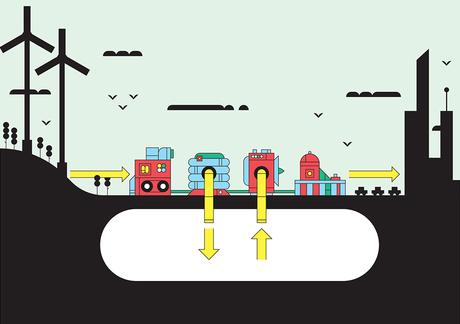
Compressed-Air Energy Storage
Wind energy is used to power compressors that inject air at high pressure into large underground chambers. When demand peaks and the wind flags, the pressurized air is released—often with a small amount of natural gas—to power turbines or generators, producing electricity. The first such plant opened in Germany in 1978.
For years, dreams of a bright green future fueled by clean sources of renewable energy have been tempered by the inconvenient reality of their intermittency. The sun doesn’t always shine, of course, and the wind doesn’t always blow, making it hard for them to consistently feed the grid that all of us count on to reliably deliver energy at the flip of a switch.
But that may at last be changing. From a set of enormous caverns in a salt formation southwest of Salt Lake City to California’s Tehachapi Mountains, experiments in mass-scale energy storage hold the promise to fundamentally reshape the way energy is produced and consumed.
The idea is simple enough: If energy from renewables can be stored and dispatched to the grid during periods of peak demand, solar and wind would become more cost-effective, simpler to scale, and truly viable alternatives to fossil fuels. “Storage has the effect of making renewable energy even more valuable because you can schedule it; you can control and dispatch it when you want it,” says Janice Lin, who leads the California Energy Storage Alliance and the newly founded Global Energy Storage Alliance.
The storage movement appears to be gathering momentum. The consulting firm Navigant reported last year that 91 grid-scale energy storage systems, with a collective capacity of nearly 363 megawatts, were launched or announced between January 1, 2013, and September 30, 2014. Like many efforts to slow the pace of climate change, the shift toward storage is being driven by California, where Governor Jerry Brown signed a law in 2011 mandating that the state generate 33 percent of its electricity from renewables by 2020. The California Public Utilities Commission followed that in 2013 by ordering its investor-owned utilities to install 1,325 megawatts of storage, also by 2020.
That explains why Southern California Edison, the state’s second-largest utility, made headlines in 2014 with a pair of bold moves that add up to a calculated bet on storage. It signed contracts for 264 megawatts of storage—a large order relative to its share of the 1,325-megawatt mandate—and it unveiled a 32-megawatt-hour lithium-ion battery facility in Tehachapi that it is treating as a “demonstration project,” in part to evaluate its potential for integrating renewable energy from wind and solar into the grid.
“We think energy storage will be a big part of the solution” to the intermittency of renewables, says David Song, a spokesman for the utility. “We’re at the forefront of it because our customers and our lawmakers demanded it of us, and we want to make sure we can meet those demands and meet those challenges.”
To the north, four companies—Pathfinder Renewable Wind Energy, Magnum Energy, Dresser-Rand, and the Duke-American Transmission Co.—have teamed up on an $8 billion plan to move energy from a proposed wind farm in Wyoming to the Los Angeles area by way of four cavernous storage chambers, each about the size of the Empire State Building, that would be carved into underground salt formations about 130 miles southwest of Salt Lake City. Jeff Meyer, managing partner at Pathfinder, describes the project—a large-scale version of what’s known as a compressed-air energy plant—as a Hoover Dam for the 21st century.
“We had some California utilities saying, ‘You can really help solve the big problem of intermittency,’” he says, “and they pointed us in the direction of the salt domes in Millard County, Utah, and they just happened to be next to the Southern Transmission System line. You put all these pieces together and you have a very cheap way, if you think about it, to deliver consistent power to a very large market.”
For Lin, of the Global Energy Storage Alliance, these projects, and the investments behind them, are signs that storage “is going to become a standard part of the tool kit that utilities and grid planners use to maintain, plan, expand, and optimize the grid.”
“It’s not the only tool,” she says, “but it’s a very valuable new one. They’re always going to have energy efficiency, they’ll always do demand response—programs that offer financial incentives to large energy consumers to cut electricity use during periods of peak demand. But this is now a really flexible asset that can make all of the above operate in greater harmony.”
Suggested reading: “Smooth Operators,” the Economist, December 6, 2014, economist.com; “Grid Energy Storage,” U.S. Department of Energy, December 2013, energy.gov; DOE Global Energy Storage Database, energystorageexchange.com; “Energy Storage Hits the Rails Out West,” Scientific American, March 25, 2014, scientificamerican.com.
